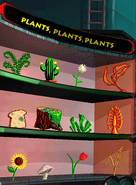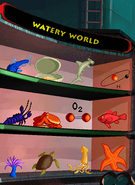The Shrinking Machine Room, also known as the Shrink-O-Matic, is one of the activities on the Second Floor in JumpStart Adventures 3rd Grade: Mystery Mountain. It is designed to teach science at a third grade level.
Description[]
The Shrinking Machine Room contains a device called the Shrink-O-Matic, which can reduce anyone or anything to the size of a "medium-large molecule", and a shelf filled with specimens (natural items, such as life forms and elements) cared for by Egbert. In the game, Polly provides a hint and the user, using Egbert's analyzer, must determine which specimen her hint refers to. They do this by clicking on the specimens while holding the analyzer, causing information about that specimen to be displayed and read by Egbert. Once the correct specimen is found, the user must move it to the Shrinking Machine and click on the microscope on the floor. Botley is then shrunk down and sent into it, and the user must play a non-educational portion of the activity (known as the Fantastic Voyager in the manual), which consists of a Breakout-like game, to find the hidden Mission Clue or Invention Points, with the bar being a magnet, Botley curling up and functioning as the ball, and "molecules" (which look like colorful spheres) functioning as the blocks to break. The goal is to hit and break a single red molecule which contains the Mission Clue and Invention Points. If the user fails to catch Botley with the magnet and he falls to the bottom of the screen, they will lose a life, and will fail the activity if all lives are lost.
Specimens[]
In each round, there are twelve specimens on the shelf to choose from. The specimens which may appear are as follows:
- amoeba
- bald eagle
- bat
- boa constrictor
- broccoli
- cactus
- carbon
- caterpillar
- catfish
- chameleon
- cicada
- clam
- coral
- coyote
- dandelion
- diamond
- dragonfly
- earthworm
- fern
- fire ant
- frog
- gecko
- granite
- hammerhead shark
- helium
- honeybee
- hummingbird
- hydrogen
- jellyfish
- kelp
- ladybug
- lava rock
- lemon
- limestone
- lion
- lobster
- marble
- mold
- mosquito
- moss
- mussels
- newt
- octopus
- ostrich
- owl
- oxygen
- peacock
- protozoan
- quartz
- rattlesnake
- salmon
- sand dollar
- sandstone
- sea anemone
- sea lettuce
- sea pen
- sea turtle
- shrimp
- slate
- slug
- snail
- sponge
- squid
- starfish
- stink bug
- sunflower
- tadpole
- tapeworm
- tarantula
- toadstool
- tortoise
- truffle
- tulip
- weevil
- wheat
Categories[]
- Call of the Wild
- Icky and Gross
- Mammals - Not!
- Meat Eaters
- No Legs!
- Plants, Plants, Plants
- Really Slow Creatures
- Rocks and Elements
- Things with Wings
- Watery World
- Things to Eat
- Watch Out-Predators!
- Fascinating Pets
- Dangerous Things
- At the Zoo
- Lays an Egg
- Slithery and Slippery
- No Bones Here
- Shells, Shells and Shells
- Things with Bones
Difficulty level differences[]
The Fantastic Voyager[]
- Level one: On the first level, Botley bounces slowly and has 10 lives.
- Level two: On the second level, Botley bounces with medium speed and has 10 lives.
- Level three: On the third level, Botley bounces really fast and has 8 lives.
Quotes[]
Egbert[]
- "So do you want to know about something?"
- "Just let me know if you need any information about my darling specimens."
- "I'm here to help if you need me."
- "Ready, Botley? Hold on tight. It is some ride, I'm told."
- "Bon voyage, Botley! That's French, you know."
- "Happy trails!"
Botley[]
- "You have to bring a specimen over to the shrink-o-matic before it can be turned on."
- "Choose carefully, we can't shrink me down too many times without having to recharge the mountain, so we have to be picky! Maybe you should use the analyzer to be sure!
- "Do you think that's the right specimen? If so, just click on the microscope on the floor."
When The Shrink-O-Matic Cannot Be Used Without Energy[]
- "The Shrink-O-Matic's dead! We've run out of power! Let's go downstairs to generate more!"
- "We can't run this thing without more power. Time to take a trip to the generator."
Digital manual description[]
What's in the Shrinking Room?[]
It seems that Polly's hidden some Mission Clues and Invention Points inside her father's scientific specimens. When you enter the Shrinking Room from the second floor of the Mountain Mansion, Polly will give you a clue that can help you identify the right specimen. There's also Egbert, the resident egghead to help you. He knows just about everything about anything in this room and will tell you if you just ask!
The Shrink-O-Matic[]
- To begin your work in the Shrinking Room, click on the Analyzer in Egbert's hand.
- To find out about any specimen in the specimen case, click on it.
- When you think you've got the specimen you want, hand the analyzer back to Egbert. He's kind of a neat freak.
- Now move the specimen to the platform in front of the Shrink-O-Matic.
- Click on the microscope to shrink Botley and get him ready for his fantastic voyage¾inside the specimen.
The Fantastic Voyager[]
Now that you've miniaturized Botley in the Shrink-O-Matic, the real fun begins! You're peering down to the molecular level of the specimen now. You've got to break away the molecules to find the object. And a shrunken Botley is your tool!
- Click your mouse to launch Botley.
- Use your mouse to move the electromagnet back and forth. You've got to aim Botley so he breaks away all the round molecules and reveals Polly's hidden Mission Clue or Invention Points.
- After you've released the prize, click on it. You can now store it in your Inventory.
Trivia[]
- The name of the latter part of this activity is a reference to the 1966 movie Fantastic Voyage.
- There are twelve specimens on the shelf with a specific category.
- Egbert's analyzer to the specimens are about animals, plants, nature, rocks, minerals, elements, and cells.
- Botley shrinks down to a molecule on the magnet.
- Sometimes, Egbert does not say the exact description for some specimens.
- Example: The coyote's description says American Indians, but Egbert says Native Americans.
Errors[]
Some specimens appear in certain categories that don't fit them, while certain words in their descriptions are inaccurate. Here's why:
- Lays an Egg
- Boa constrictor: It actually gives live birth.
- Fascinating Pets
- Hammerhead shark: It's too illegal to be a proper pet.
- Bald eagle: It's too illegal to be a proper pet.
- Amoeba: It's too microscopic to be a suitable pet.
- Plants, Plants, Plants
- Mold: It's a fungus.
- Sea pen: It's a type of coral with a soft body.
- Toadstool: It's a fungus. The game even says that toadstools are no longer considered plants.
- Descriptions
- Fire ant: They're venomous, not poisonous (i.e. if it bit you and you die, it was venomous, and if you bit it and you die, it was poisonous).
- Hammerhead shark: Calling it ferocious is rather unfair, since hammerheads don't target humans as food as they can mistake humans for prey, they're normally harmless, unprovoked attacks are uncommon, they rarely attack humans, and if they do attack, it's only when they're provoked. Therefore, calling it "aggressive" would be more fair, since hammerheads are just naturally aggressive.
- Jellyfish: The animal contains venom, not poison.
- Octopus: Its limbs are called tentacles, but it actually doesn't have tentacles, only six arms and two legs. The tentacles of a cephalopod have flattened tips and only the suckers are on the tips (found on squid and cuttlefish), while arms and legs are entirely lined with suckers. The beak of an octopus is technically not its mouth, but rather a hardened structure in the mouth, which is the circular hole itself.
- Squid: A squid actually has eight arms (and two long tentacles) and the octopus has six arms (with two legs). The giant squid isn't actually the world's largest invertebrate as it's really the colossal squid; the giant squid may be longer, but the colossal squid is heavier, even during the latter's maximum length, which is said to be 45-46 ft (or 13.7-14 m).
- Sea anemone: The animal produces venom, not poison.
- Peacock: In both title and description, the term "peacock" refers to both male and female species of colorful bird. In actuality, "peacock" refers to only the males, while "peahen" refers to the females. "Peafowl" is the correct term that encompasses both genders.
- Ladybug: Its name is spelled as "lady bug," but it should be "ladybug." Also, while commonly called ladybugs, scientists increasingly prefer the term "ladybird" or "lady beetle" since ladybugs are not true bugs.
- Sea lettuce: It refers to something that belongs in a salad, but you wouldn't want to eat it. However, sea lettuce's name isn't misleading since it's actually an edible green algae. Therefore, it's perfect for salads.
- Amoeba: It's called an animal, but it's actually a cell.
- Starfish: While commonly called starfish, recently scientists prefer "sea star" since they're not even fish.
- Rattlesnake: Contrary to popular belief, rattlesnakes, and all other snakes, are not deaf. Even though they lack outter ears and eardrums, snakes can sense vibrations and low-frequency sounds through their lower jaws that have inner ears.
- Catfish: A catfish's feelers are called whiskers, but they're actually barbels since whiskers are made of hair.
- Chameleon: While a chameleon is widely believed to change its color to match its surroundings, it's actually inaccurate that chameleons use their color change for camouflage. A chameleon really changes its skin color to adjust to temperatures and show its mood.
- Mosquito: Female mosquitoes actually drink the blood, rather than eat it.
- Owl: Owls are thought to turn their heads all the way around to look, but it's a misconception. In reality, they only spin their heads a long way.
- Tortoise: Turtles and tortoises aren't the only reptiles with shells; the terrapins are also shelled reptiles.
Gallery[]
Screenshots[]
Videos[]

JumpStart 3rd Grade - The Shrinking Room










